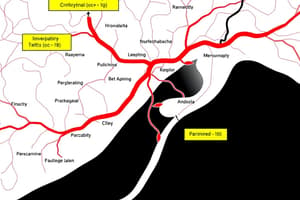Podcast
Questions and Answers
Topical application is used when a local effect of the drug is ______.
Topical application is used when a local effect of the drug is ______.
desired
Clotrimazole is applied as a cream directly to the skin in the treatment of ______.
Clotrimazole is applied as a cream directly to the skin in the treatment of ______.
dermatophytosis
Tropicamide or Cyclopentolate are ______ directly into the eye to dilate the pupil.
Tropicamide or Cyclopentolate are ______ directly into the eye to dilate the pupil.
instilled
The rectal route has the advantage of preventing the destruction of the drug by intestinal enzymes or by low ______ in the stomach.
The rectal route has the advantage of preventing the destruction of the drug by intestinal enzymes or by low ______ in the stomach.
The rectal route also bypasses the portal ______.
The rectal route also bypasses the portal ______.
This minimizes the biotransformation of drugs by the ______.
This minimizes the biotransformation of drugs by the ______.
The rectal route is useful if the drug induces ______ when given orally.
The rectal route is useful if the drug induces ______ when given orally.
Disadvantages of the rectal route include discomfort, inconvenience and many drugs irritate the rectal ______.
Disadvantages of the rectal route include discomfort, inconvenience and many drugs irritate the rectal ______.
Rectal administration is beneficial if the patient is already ______.
Rectal administration is beneficial if the patient is already ______.
Topical application allows for a direct effect on the ______.
Topical application allows for a direct effect on the ______.
Flashcards are hidden until you start studying
Study Notes
Parenteral Routes Overview
- Parenteral routes bypass the digestive system, allowing for direct entry into the systemic circulation; irreversible and may cause pain and risk of infections.
- Key types: intravascular, intramuscular, and subcutaneous, each with unique benefits and limitations.
Intravascular (IV) Route
- Most common parenteral route; drug is injected directly into a vein.
- Advantages:
- Immediate action and precise control of drug levels in circulation.
- Allows administration of large volumes through IV infusion.
- Disadvantages:
- Risk of toxicity with rapid administration.
- Only fluid solutions can be used.
- Potential for local venous thrombosis and infection.
Subcutaneous (SC) Route
- Drug injected into the tissue just below the skin.
- Advantages:
- Provides slow and controlled drug absorption.
- Absorption rate can be modified by manipulating blood flow.
- Disadvantages:
- Limited to small volumes per injection.
- Repeated injections may cause lipoatrophy.
Intramuscular (IM) Route
- Drug injected into muscle mass.
- Advantages:
- Faster absorption compared to subcutaneous injections.
- Absorption rate can be altered by changes in blood flow.
- Disadvantages:
- Risks include potential for infection or nerve damage.
- May cause pain at the injection site.
Enteral Routes
- Simple and commonly used drug administration methods, primarily through oral intake.
- Oral Advantages:
- Self-administered and does not require sterilization.
- Overdoses can often be managed with antidotes.
- Cost-effective relative to parenteral routes.
- Oral Disadvantages:
- Ineffective absorption for some medications; first-pass metabolism can greatly reduce efficacy.
- Not suitable for emergencies or individuals unable to swallow.
Sublingual Route
- Drug placed under the tongue for direct absorption into the bloodstream.
- Advantages:
- Quick absorption; bypasses gastrointestinal metabolism.
- Minimizes risk of local infection.
- Disadvantages:
- Drug taste may be unpleasant.
- Not suitable for long-term medication.
Other Administration Routes
- Inhalation: Rapid delivery through respiratory tract; effective for respiratory conditions.
- Intrathecal: Direct injection into cerebrospinal fluid, useful for central nervous system drugs.
- Intracardiac: Emergency injection directly into the heart; used in cardiac arrest.
- Topical: Local effects achieved through skin or mucous membrane application; minimizes systemic absorption.
- Rectal: Prevents drug degradation in the GI tract; useful when oral intake is not possible, but can irritate the rectal mucosa.
Injection Techniques
- Intramuscular: Inject at a 90° angle.
- Subcutaneous: Inject at a 45° angle.
- Intravenous: Inject at a 26° angle.
- Intradermal: Inject at a 10-15° angle.
Studying That Suits You
Use AI to generate personalized quizzes and flashcards to suit your learning preferences.



